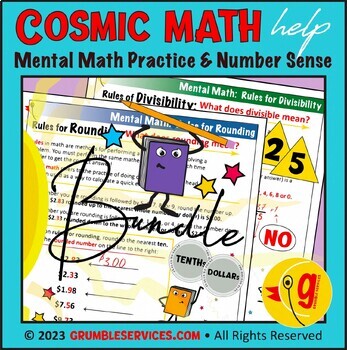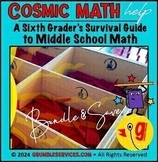Mental Math Practice & Number Sense: Dividing & Rounding Rules, Calculating Tip
- Zip
Products in this Bundle (5)
Also included in
- Cosmic MATH: Montessori Pegboard Decimal Board Fractions Algebra & Word Problems (and much more!) BUNDLE • Elementary, Montessori-inspired Math Materials for the Classroom or for your Homeschool!Montessori-inspired Math help Materials: What a time saver! Matching activity cards, Word Problem carPrice $75.00Original Price $106.50Save $31.50
- A Sixth Grader’s Survival Guide to Middle School Math: Higher Level Thinking BUNDLE • VETERAN Montessori-inspired printable Math & Geometry help:This bundle is 35% Off for a limited time only!Recommended to be used in this order:Number Operations • Algorithms, word problems & averaging reviePrice $50.00Original Price $79.45Save $29.45
Description
Mental Math Practice & Number Sense: Dividing & Rounding Rules, Calculating Tip Math BUNDLE - Mixed-level Montessori-inspired printable Extra Math help (10 pages + key):
These quick, little Extra Mental Math Exercises go over:
- Review the most common rules for Divisibility (2, 5, 10, 25)
- Practice the standard rule for Rounding (whole numbers, decimal & mixed numbers)
- Explore a quick shortcut to calculating 10% and 20% of a number.
How does memorizing rules help us with mental math? Here are some of the most common rules for dividing, rounding, and calculating tip. This can be used as a fun review for the older student.
Do you like the Mental Math Practice & Number Sense: Dividing & Rounding Rules, Calculating Tip Math BUNDLE? Please consider other EXTRA MATH HELP learning resources from Grumble!
Rounding Rules for Whole Numbers - Elementary Math Help pages
Division Divisibility Rules 10 & 25 - Elementary Math help pages
Number Operations & Terminology - Elementary Math help pages
Looking for High Quality, Professionally Designed Elementary Learning Resources? Look no further - FOLLOW GRUMBLE! Although the word Montessori is in the title, ANY type of elementary student will benefit from independent, self-directed learning.
As stated in the Teachers Pay Teachers refund policy, “all sales on TpT of digital resources are considered final and nonrefundable.” Please ask any questions you have about this product before purchasing. Thank you!© 2020-2024 Grumbleservices.com • All rights reserved.
Dr. Maria Montessori believed the only way our world would find lasting peace was through educating our children. Much of her elementary curriculum was written by her during a period of internment in India during WWII. This time period helped solidify Dr. Montessori’s belief in Peace Education.
Resource Color Guide (just like the Montessori hierarchical colors):
ROOKIE Pages (Green) - Aimed toward early to mid level elementary students.
SEMiPRO Pages (Blue) - Aimed toward mid level elementary students.
VETERAN Pages (Red) - Aimed toward mid to late level elementary students.
But of course, you know the child best, so adjust accordingly.
In the words of Dr. Montessori, "Follow the Child!"







